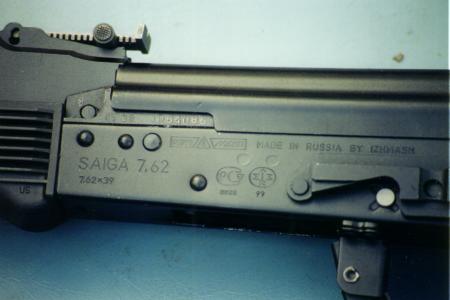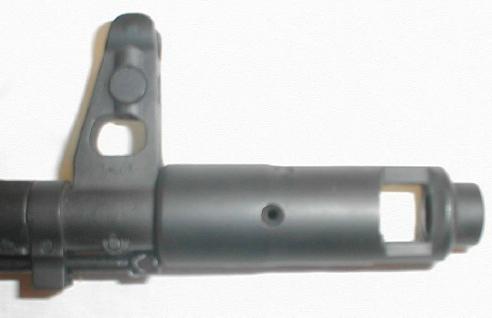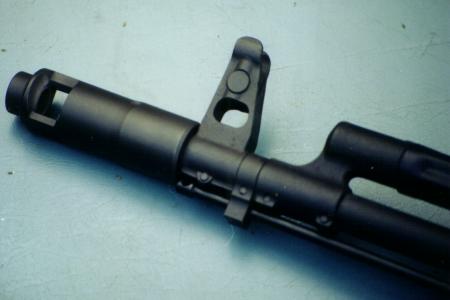 |
Israeli 7.62mm
K98k
Carbine |
 |
|
|
|
|
CRUFFLER.COM
presents
FIREARM
REVIEW,
January
2001:
 |
Israeli 7.62mm
K98k
Carbine |
 |
| Type: Bolt action
rifle
Caliber: 7.62mm NATO Capacity: 5 round internal box magazine Sights, front: Blade, adjustable for windage Sights, rear: Tangent U-notch adjustable for range Length: 43.7" Barrel length: 23.62" Weight (unloaded): 8.6 lbs Suggested Retail Price: $240.00 |
The K98k's service life
A strong case can be made for naming Mikhail Timofeyevich Kalashnikov the most important firearms designer of the 20th century. More than fifty million Kalashnikov rifles and light machineguns have been manufactured since the design's introduction in 1947. At least a dozen countries have manufactured or are manufacturing one form or another of the basic AK-47 rifle. Kalashnikov rifles, submachineguns and support weapons are in daily use by at least fifty-five countries and countless terrorist and guerilla organizations. No other military small arm has achieved this level of universality. The two that come closest, the Belgian FAL and the US M16 series lack the depth and breadth of the Kalashnikov (neither has been adapted into a successful support weapon). The latest versions of the Kalashnikov rifles are the folding polymer stocked "century series," which include the AK-105 5.45mm submachinegun, the AK-101 5.56mm assault rifle, the AK-102 5.56mm submachinegun, the AK-104 7.62mm submachinegun, and the AK-103 7.62mm assault rifle.
Kalashnikov designs, most notably the AK-47, have attracted attention in sport shooting as well as military circles, and have a large following among American firearms enthusiasts. While owning the selective fire version of the AK presents significant financial and legislative hurdles, the design is readily adaptable into a semiautomatic only form, and arms makers wasted no time in filling the demand for semiautomatic AK rifles. Kalashnikovs from a number of countries, including China, Hungary, Egypt, Romania, and Bulgaria were provided to the American market. They were relatively inexpensive, cheap to shoot, and a great deal of fun. However, after the infamous "assault weapon" ban of 1994, the various AK clones suffered a dip in popularity. Overnight, features unrelated to the rifle's operating mechanism were proscribed. Muzzle devices, bayonet lugs, and separate pistol grips could no longer be fitted to the imported rifles. Collectors, shooters, and military enthusiasts were simply uninterested in the neutered thumbhole stocked versions. By and large the "legislative compromise" AK clones were uncomfortable to hold, unattractive, and an unappetizing reminder of legislative reverses. Despite the legal hurdles, there was a continuing strong interest in AK variants in the original configuration, evidenced by the brisk trade in "pre-ban" guns.
The ban operates on two axes: It both prohibits the importation of certain named firearms, as well as the assembly of similarly featured guns using imported parts, i.e. the conversion of a "post-ban" gun to one with "pre-ban" features. Specifically, a semiautomatic rifle of a type prohibited from importation, may not be legally assembled if it uses more than ten imported parts of a list of twenty enumerated in Title 27, Code of Federal Regulations, Section 178.39 (the regulatory amplification of Title 18 US Code Section 922r). This list includes:
(1) Frames,
receivers, receiver castings, forgings or stampings
(2) Barrels
(3) Barrel
extensions
(4) Mounting
blocks (trunions)
(5) Muzzle
attachments
(6) Bolts
(7) Bolt carriers
(8) Operating
rods
(9) Gas pistons
(10) Trigger
housings
(11) Triggers
(12) Hammers
(13) Sears
(14) Disconnectors
(15) Buttstocks
(16) Pistol
grips
(17) Forearms,
handguards
(18) Magazine
bodies
(19) Followers
(20) Floorplates
The firearms industry was quick to capitalize on this regulation. If a number of American produced parts could be substituted for the originals, the rifles would be legal for assembly and in full compliance with the law. The AK uses sixteen of the twenty. Two companies, First Son Enterprises and Soupbowl Enterprises market the six part sets (pistol grip, disconnector, sear, hammer, trigger, and gas piston) required to ensure legal status for AK variants. As a result, a new crop of AK style rifles is now available to the American firearms consumer. These rifles are true to the original AK configuration, excepting the lack of a bayonet lug. Among the rifles currently available to American consumers are Romanian and Bulgarian versions of the AK-47, the AKM, and the AK-74.
Kalashnikov-USA
Post-communist
Russia was well aware of the commercial possibilities in the United States,
and worked to take advantage of them. Izhmash, the arms center of
the Russian Federation, which manufactures AK rifles for the Russian military
and and for export, as well as a series of sporting rifles, was keenly
interested in exploiting the US commercial market. Among these sporting
rifles made by Izhmash is the Saiga carbine. The Saiga, chambered
for the 7.62x39mm cartridge, is little more than a century series AK specially
modified to meet the needs of hunters and target shooters. The pistol
grip is done away with and replaced with a sporter stock. The trigger
is moved rearward, so that it may be comfortably reached from the reconfigured
stock. The
16" military barrel is replaced with a 20" sporting barrel, and the forearm
is reconfigured. Perhaps the most important difference is that the
Saiga lacks a feed ramp. Additionally, the magazine catch is longer
in profile. As a result, the Saiga will only function with a specialized
magazine and will not work with standard AK magazines. Saigas are
imported by Kalashnikov-USA,
which is based in Port St. Lucie, Florida. Kalashnikov-USA has been
in business since 1997, and imports a full range of Izhmash sporting rifles
and accessories, to include Saigas in 7.62x39mm and .308 Winchester, Los-7
bolt action rifles, optical and collimator sights, and other firearms accessories.
The marketing staff at Kalashnikov-USA were quick to realize two things: One, that there would be a very significant consumer demand for an actual Russian Kalashnikov rifle, and two, the importation of such a rifle in military or pseudo- military configuration, when combined with the company's high profile name, might garner significant amounts of unwanted attention. As a result, it was decided to

AK-103 Markings - Note IZHMASH Tradename and Proofs |
import Saiga rifles in 7.62x39mm, and have them converted into a close approximation of the AK-103. This made sense for a variety of reasons. The Saiga uses the same basic receiver, barrel, and gas system as the AK-103, so conversion was largely (but not entirely) a matter of cosmetic adaptation. Additionally, since the Saiga is classed as a sporting rifle, and it cannot accept high capacity AK magazines, importation is not a problem. |
Initially, the conversion effort was undertaken by another manufacturing gunsmith. Production difficulties and philosophical differences soon led to the dissolution of the partnership between Kalashnikov-USA and that organization. The conversion effort was then undertaken by Krebs Custom Gunsmithing.
Krebs Custom
Gunsmithing
Krebs Custom
Gunsmithing is owned and operated by Marc Krebs. Krebs began his
career in 1985 in general gunsmithing. Around 1994 Krebs began to
specialize in building custom pistols for IPSC and other competitive shooting
sports. Whatever his professional orientation, Krebs has always
had an interest in AK rifles, and has always marveled at the design's inherent
reliability and robust nature. This personal and professional interest
in the AK has culminated in the current AK-103 being offered by Kalashnikov-USA.
A Krebs AK-103
starts as a 7.62x39mm Saiga rifle supplied to by Kalashnikov- USA.
As Krebs notes, the Saiga is basically a century series AK in commercial
clothing. The Saiga is stripped to its individual components, and
carefully re-manufactured. The rivets that hold the trigger parts
are removed, the triggerguard reshaped and reinstalled, and the trigger
mechanism moved to where it would be on a standard AK. The barrel
is bobbed to approximately 14.5 inches and fitted with a permanently attached
fourth generation AK-74 style muzzle brake of approximately 2 inches in
length, which brings the barrel length past the legal minimum of 16 inches.

Krebs AK-103 Muzzle Brake, Right Side |

Krebs AK-103 Muzzle Brake, Left Side |
To enable the rifle to function with standard AK magazines, it was necessary for Krebs to fit a feed ramp to the rifle. The feed ramp is hand crafted from either 01 tool steel or 4130 steel tubing, and carefully welded in place below the barrel. We carefully compared the Krebs feed ramp to purpose built feed ramps on three other AK style rifles and could find no difference in either form or function.
The fire control group (trigger, sear, disconnector, and hammer), gas piston, and pistol grip are replaced with the required American made parts to ensure that the completed rifle's compliance with relevant firearms laws. Finally, any metal discolored during the re-manufacturing process is refinished with bake on automotive lacquer, and the rifle is reassembled with black military furniture. While the original AK-103 boasts a folding stock, this is not possible due to current laws, and the Krebs gun has the same fixed stock as current production AK-74 rifles.
PRODUCT
REVIEW
Curious about
the AK-103, we ordered one from Kalashnikov-USA. The rifle arrived
a few days later. Immediately, we were struck by the care and thought
that had gone into the package. Instead of coming in a cardboard
box, as is the norm, the rifle was shipped in a lockable hard plastic case.
In addition to the rifle, the package included:
Well satisfied with the external inspection, we disassembled the rifle and did a more thorough inspection. The chrome lined bore was slightly dirty from test firing, but otherwise perfect. A headspace check yielded no surprises, with the bolt closing easily on a Clymer 7.62x39mm GO headspace gauge (1.2713"), and failing to close on a NO-GO gauge (1.2773"). All parts disassembled and reassembled exactly as expected. We reassembled the gun, with the exception of the dust cover, and conducted an action proving test.
Disconnector
Difficulties
This test
consists of loading a pair of dummy cartridges into a magazine, racking
the bolt, and watching the system's behavior. Feeding was perfect,
as expected. The trigger pull was very pleasant, being both crisp
and light. Retracting the bolt, the "spent" dummy cartridge extracted
and ejected properly. Easing the bolt forward, the second dummy cartridge
fed perfectly into the chamber. All was well until we noticed that
the hammer had followed the bolt forward. Investigation revealed
that there was a problem with the disconnector.
The AK, like other self loading designs that fire from a closed bolt, has a disconnector that prevents the hammer from moving forward after the bolt has cycled, but before the trigger has been released and pressed again by the shooter. The result of a disconnector failure can range from the rifle failing to operate semiautomatically, to accidental full automatic fire, to an out of battery discharge. While less prone to be destructive in the AK, out of battery discharges are by far the worst, as they can result in detonations that can not only destroy the gun, but seriously injure the shooter. What we discovered was that the disconnector was failing to grab the hammer, there being a gap of approximately a millimeter between the two components. With the disconnector problem being what it was, the gun was unsafe to shoot. We reported the problem to Kalashnikov-USA, and within fifteen minutes received a call from Marc Krebs. Krebs immediately knew what the cause of the problem.
Our AK-103 had been assembled with the requisite American made fire control parts. For whatever reason, the fit of these parts within the AK-103 receiver was less than optimal. Krebs immediately offered to pay shipping charges so that he could replace the fire control parts with First Son Enterprises parts. We returned the rifle to Krebs, and received it back a few days later. Krebs' level of customer service was impressive - the rifle was sent back to us at Krebs' expense. Subsequent inspection revealed that the disconnector problem had been entirely cured with a minimal bit of fitting.
This particular
problem has been effectively overtaken by events, as Krebs Custom is now
having a CNC machined fire control parts set made to Marc Krebs' own specifications.
Future
Shooting
the AK-103
Despite the
initial setback we were enthusiastic about shooting the AK-103. Peter
Thomson, marketing director at Kalashnikov-USA had promised us some impressive
accuracy, and had offered to supply us with a Cobra red dot collimator
sight to use during accuracy testing. And thus, toting the latest
and greatest in EBR's, we headed off to the NRA range in Fairfax, Virginia.
Ammunition
We brought
along three types of 7.62x39mm ammunition with which to test the AK-103:
Sellier &
Bellot 7.62x39mm 123 grain FMJ
Russian Barnaul
7.62x39mm 122 grain JHP
Russian Barnaul
7.62x39mm 123 grain FMJ
Accuracy
Our initial
accuracy results were not anything special. This, however, had more
to do with our spending an inordinate amount of time trying to sight in
the Cobra sight rather than shooting the AK-103 for accuracy. As
it turned out, we never did get the sight zeroed during that sitting.
It took a return back to the office, and actually reading the instructions
to figure out how to make the necessary coarse adjustments to the sight.
Feeling rather sheepish, we returned to the range.
We set the target out at 25 feet for zeroing, firing three shot groups. It was a gratifying surprise to see those three shot groups cutting one hole in the paper. Once zeroed at 25 feet, we wheeled the target out to 40 feet, and were again treated to three shot, one hole groups. No difference was noted between ammunition types. When satisfied that both the rifle and the Cobra sight were looking at the same place, we pushed the target out to the 50 yard mark, the maximum distance possible at the NRA range. After some very nice three shot groups, we loaded up a thirty round magazine, and began to very deliberately shoot at the target. When it was over, we were very happy to see that, with the exception of two fliers, every round had impacted in a one inch by one and a half inch area in the center of the target. Given the combination of a short barrel, indifferent ammunition, and our less than match quality shooting abilities, this speaks volumes for the rifle's capabilities.
We held the rifle to between two and three minutes of angle, and fully believe that in the hands of better shooters, the rifle offers significant potential for even better accuracy. It also compares well to its contemporaries, the FAL, the G3 and the M16, which are designed to shoot approximately three minutes of angle with military ammunition. In other words, the AK-103 is not only very accurate for an AK, but for self loading military rifles in general.
Recoil and
Ergonomics
While recoil
with an intermediate cartridge like the 7.62x39mm is never great, there
is always some discernible muzzle rise. This was not the case with
the AK-103. In fact, we didn't notice any muzzle rise when firing
two and three shots rapidly. We attribute this to the very effective
AK-74 style muzzle device. In fact, this may be the single most effective
muzzle device on any military style rifle we've fired.
The stock configuration, like all AK's, seems oddly small to the American shooter at first. (NB - at customer request, Krebs can supply a stock that is two inches longer.) However, with very little time, the gun comes naturally to the shoulder, and the sight to the eye. While the majority of people will find the AK-103 very comfortable, large shooters may experience some discomfort. The worst ergonomic feature of the AK-103 is one that it shares with the entire AK series. Specifically, the forearm and handguard do not offer much in the way of heat dissipation. They get hot, quickly. While this is not an issue for a sporting or plinking rifle, it is less than advisable to grab the forearm after firing five or seven magazines as quickly as possible!!
Reliability
Yet again,
we failed. No matter what we did, we couldn't get the AK-103 to jam.
We tried "limp wristing" the gun. We fired it while canted ninety
degrees to both the right and left, and we fired it upside down.
No matter what we did, the gun never missed a beat, and kept going with
no failures to feed, fire, extract, or eject.
Conclusion
Kalashnikov-USA
bills the AK-103 as the Cadillac of AK rifles. After a detailed
and thorough investigation, we find ourselves agreeing. While this
gun is no more reliable than less expensive AK clones, such as the Romanian
SAR series, it is made to significantly higher standards of fit and finish.
It is also equipped with a very effective muzzle brake, and, based on our
experience, it is significantly more accurate. This isn't really
surprising, however, as the gun starts with high quality raw materials
and mates them with a combination of years of gunsmithing experience
and painstaking attention to detail. The result is a wonderful product
that meets the most exacting standards of performance and construction.
All this excellence has a price however, and the AK-103 is priced
at some $200 - $300 more than comparable products. However, this
is essentially a hand made firearm of excellent quality, fit, finish,
and performance, and, we believe, well worth the investment.
And now, our
Buy-O-Meter rating for the AK-103:
 |